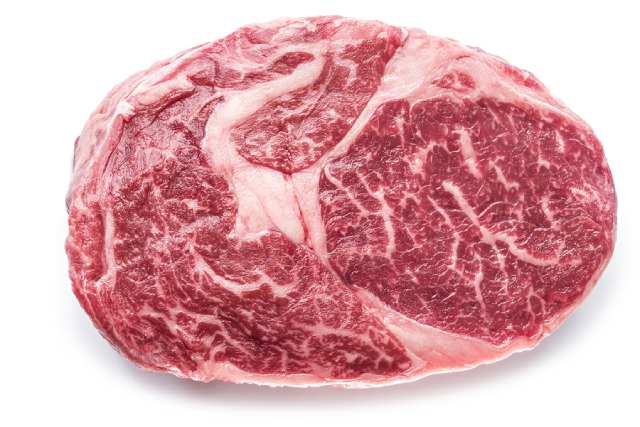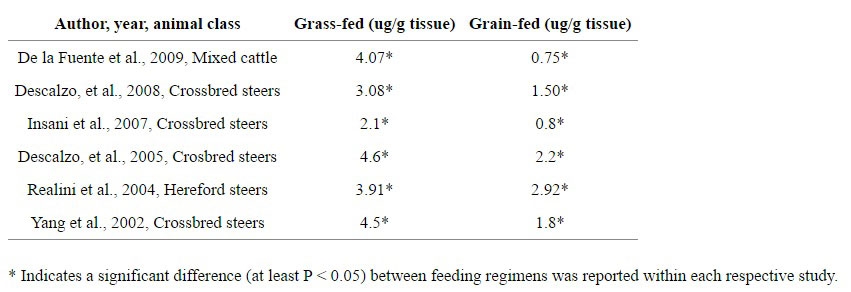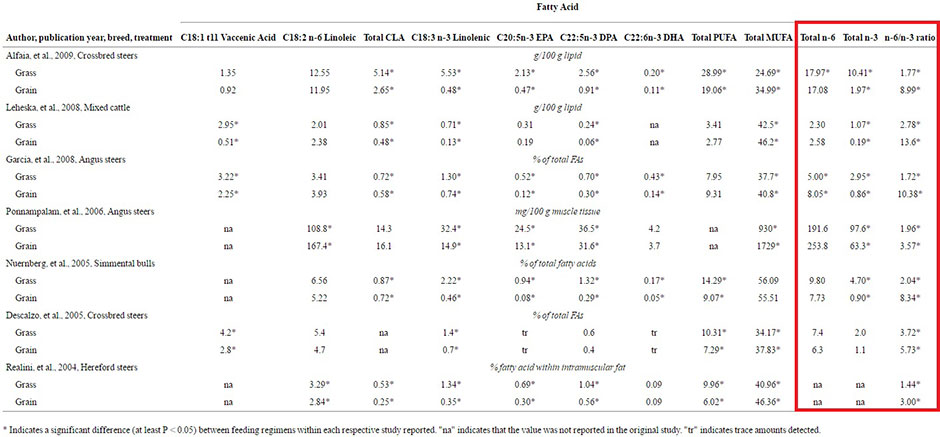Grass Vs Grain Fed Beef Nutrition
Last Updated on May 8, 2021 by
Need for grass-fed 'pastured' beef has increased chop-chop over the past decade.
Information technology is also mutual to hear claims that grass-fed beef is healthier, cleaner, and more humane than grain-fed meat.
Even so, is information technology true that grass-fed beef is nutritionally superior?
This article takes a propaganda-free await at the arguments both for and against grass-fed beef.

Annotation
There are legitimate ecology and fauna welfare concerns almost how beef is produced.
That said, these issues are across the telescopic of this commodity, which will focus solely on the nutritional arguments.
Producing grass-fed and grain-fed beef
Showtime of all, most cattle are "grass-fed" for the majority of their lives.
According to livestock experts at Pennsylvania Land University, the vast majority of cows spend the first two-thirds of their life feeding on pasture (one).
However, there are some differences in the mode in which grass-fed and grain-fed beef are produced.
Grass-fed
Pastured cows are primarily raised on a diet of grass, and they volition generally consume hay (dried grass) in the wintertime (2).
As before mentioned, most cattle spend a significant amount of time grazing on pasture, simply it is in the concluding third of their life that some cardinal differences brainstorm to sally.
For example, many cattle are "grain-finished," which may mean the cows spend the concluding tertiary of their life in a feedlot.
A smaller proportion of cattle spend their entire lifetime grazing on pasture, and beef from these cows may be labeled "100% grass-fed".
Grass-fed beef is relatively common in countries such as Australia, New Zealand, and the Uk.
However, merely 4% of cows spend their lives on pasture in the United States, and 96% movement to feedlots (three).
Grain-fed
In contrast to grass-fed cattle, grain-fed cows spend the latter portion of their life feeding on grains, ofttimes in a feedlot.
The verbal grains used for feed will differ by farm and land, but these grains typically include barley, corn, sorghum, and soy (4).
These grains are all loftier-energy feed options, and they event in increased musculus growth and weight gain in the cows.
For this reason, grain-feeding is preferred by many farming operations due to the enhanced efficiency and profitability it offers. Grain-fed beef also represents the bulk of beef produced within the Usa (5).
Key Betoken: Grass-fed beef comes from cows fed on grass for the majority of their lives. Conversely, grain-fed beef comes from animals that feed on grains during the latter part of their lives.
The bones nutrition profile of grass-fed beef vs. grain-fed beef
All beef is nutritious and an excellent source of protein, vitamins, and minerals.
Withal, there are some minor nutritional differences between grass-fed and grain-fed beef.
In the following table, we tin can run into how grass-fed and grain-fed beef compare nutritionally on a per-100-gram ground.
The corresponding data is for regular (raw) footing beef, sourced from the USDA's FoodData Central database (6, seven).
| Calories/Food | Grass-fed, basis beef | Grain-fed, ground beef |
|---|---|---|
| Calories | 198 kcal | 247 kcal |
| Saccharide | 0 g | 0 g |
| Fat | 12.73 g | xix.07 g |
| Saturated | 5.34 g | 7.29 thou |
| Monounsaturated | 4.eighty g | viii.48 1000 |
| Polyunsaturated | 0.53 g | 0.51 g |
| Protein | xix.42 g | 17.44 grand |
The in a higher place data provides a general idea of the potential nutritional differences between grass-fed and grain-fed beef.
More often than not speaking, the cardinal distinction is that grass-fed beef is leaner than grain-fed beef.
However, it should be noted that the precise nutritional values can vary depending upon the feeding regime. For example, the quantity of grains the cows eat and their ability to practise can both affect the leanness of the beef.
Cardinal Point: Grass-fed beef is unremarkably leaner than grain-fed.
Nutrients and compounds in beef
There are too some specific differences between grass-fed and grain-fed in the concentration of nutrients and other compounds that occur in beefiness.
Conjugated linoleic acid (CLA)
Conjugated linoleic acid, otherwise known as CLA, is a natural trans-fat.
While the "trans-fatty' name may draw concern, it does non accept the aforementioned furnishings equally artificial trans-fats, and it has neutral/negative associations with cardiovascular affliction (8, ix).
Further, pre-clinical and homo trials suggest that CLA may even have a range of benign health effects (x).
A recent systematic review and meta-analysis of clinical trials also demonstrated that CLA supplementation might slightly reduce body weight. Still, the results were not considered clinically significant (eleven).
Ruminal bacteria play a office in the production of CLA, which is why we can find CLA in dairy/meat from ruminants (12).
Studies looking at the full CLA content of beefiness consistently demonstrate that grass-fed beef provides a greater concentration of the fatty acid (13).
Key Point: Grass-fed beef contains more than conjugated linoleic acid than grain-fed beefiness.
Fat-soluble vitamins A and E
Grass-fed beefiness is a richer source of the fat-soluble vitamins A and E.
Regarding vitamin A, cows feeding exclusively on grass consume a greater amount of carotenoids.
Carotenoids are precursors to provitamin A (retinol), which is the bioavailable form of the vitamin (14).
On this note, studies show that beef from pasture-fed cattle can have up to seven times higher carotenoid content than grain-fed beef (xv, 16).
Additionally, grass-fed beef contains significantly higher concentrations of vitamin East.
The tabular array below displays the findings of studies that compared the vitamin E content of grass-fed and grain-fed beef (17):

As shown from these results, grass-fed beef broadly provided at to the lowest degree twice equally much vitamin Due east as grain-fed beef.
Key Point: Grass-fed beef has a higher concentration of fat-soluble vitamins.
Monounsaturated fat content (oleic acrid)
The predominant monounsaturated fatty acid in beef is oleic acid (xviii).
For those unaware, oleic acid is likewise commonly referred to as the "center-healthy" fatty acid in olive oil.
Co-ordinate to the United states Food and Drug Assistants (FDA), at that place is"supportive just not conclusive bear witness"that daily consumption of oleic acid may reduce the chance of heart disease (19).
Mainly due to the fact that grass-fed beef is leaner, information technology contains a smaller amount of monounsaturated fatty than grain-fed beef. This is because the oleic acid content of beef increases with the amount of marbling.
In this regard, a range of studies demonstrates that grass-fed beef has approximately 30-seventy% less monounsaturated fat than grain-fed beef (20).
Key Indicate: Grain-fed beefiness typically has a higher fat content and a greater amount of marbling. For this reason, it is besides higher in monounsaturated fat.
Omega-three content
Meat from grass-fed animals contains a college amount of omega-3.
The beneath data shows the results of six studies investigating the fat acrid contour of both grass-fed and grain-fed beef (21):

Every bit the table shows, grass-fed beef consistently contains a higher amount of omega-3. Additionally, information technology has a lower omega-6 to omega-3 ratio.
Some researchers believe that the ratio of omega-half dozen to omega-3 may be important for human health. One of the reasons backside this is that traditional man diets had an omega-half-dozen to omega-3 ratio of effectually ane:ane. In the present day, this ratio is thought to exist as loftier as 20:1 in the boilerplate Western-style diet (22, 23).
However, it is worth remembering that beef is not a significant source of either omega-3 or omega-6. Beef mainly consists of saturated and monounsaturated fat; it contains only 0.5 grams of polyunsaturated fatty per 100 grams (5, 6).
Central Point: Grass-fed beef has a higher omega-three content than grain-fed beef.
Taste
Grass-fed and grain-fed beef have a unlike taste, and nosotros can attribute a lot of this to the varying levels of fat and marbling between the ii.
Generally speaking, fattier cuts of beef are more than prized, and we can see an example of this with Japanese Wagyu.
Wagyu has uncommonly high levels of fat/marbling, and this is a pregnant factor in why it tastes good.
In short, many people prefer the taste of fattier cuts of grain-fed beef. This assertion is supported by palatability console scores that encounter grain-fed beef significantly outperform grass-fed beefiness (24).
Grass-fed beefiness may not be as tender every bit grain-fed beef due to the (typically) lower fatty content.
Additionally, grass-fed beef tends to have a stronger and "meatier" flavor like to other leaner meats such as bison and venison.
Key Point: People tend to enjoy the taste of grain-fed beefiness more grass-fed.
Is grass-fed or grain-fed beef the better choice?
Overall, both grass-fed and grain-fed beef have benefits and drawbacks.
Based solely on the nutrition profile, grass-fed beef is slightly superior due to its higher vitamin and CLA content. It is also more protein-dense.
However, the differences are only minor, and all types of beef offer skilful nutritional value.
It is also worth considering the price; grass-fed beef typically costs effectually 30% more than than grain-fed beef.
Affordability and taste preferences are simply as relevant as the nutritional profile too. Therefore, the superior choice is the i that all-time meets the needs of each individual.
For more than on meat, see this guide to the benefits and drawbacks of reddish meat.
Source: https://www.nutritionadvance.com/grass-fed-vs-grain-fed-beef/

Belum ada Komentar untuk "Grass Vs Grain Fed Beef Nutrition"
Posting Komentar